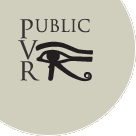The Egyptian Oracle
The Egyptian Oracle performance is a live reenactment of an authentic public ceremony from ancient Egypt’s Late Period. We project our Virtual Egyptian Temple on the wall at life scale extending the physical theater into virtual space. The temple is not a film, not a static image, but a true three-dimensional space, which the audience navigates during scene changes. The central actor is a high priest, an avatar controlled by a live human puppeteer, hidden offstage. The supporting actress stands in front of the screen, in costume, mediating the experience. Audience members represent the Egyptian populace acting out brief roles in the drama. Finally, the sacred boat (left) is another puppet also controlled by the puppeteer. In the drama, the will of the temple god moves the boat. Either video is better than any explanation:
The show conforms to a high level of historical accuracy, suitable for any museum setting. Members of the audience come before the god with questions and problems to be solved. The priest poses questions to the god, and interprets the movements of the boat as divine revelation, with the force of law; the processional Oracle was an essential feature of Egyptian public life during this period. The National Endowment for the Humanities (USA) funded the development of the performance, evaluation, and open-source software (HD-5120910).
Credits
Senior Staff
Jeffrey Jacobson, Ph.D. Project and Technical Management. Evaluation design and analysis. Configuration management. Interim and final reports. Distribution websites.
Robyn Gillam, Ph.D. Egyptology. Provided source materials, constraints and an educated viewpoint during our creative process.
Friedrich Kirschner Programming. His extensive background in film and previous experience with digital puppetry was crucial and very welcome.
Brad Shur Puppeteering. Performed in all shows and gave invaluable advice and insight on the dramaturgical needs of the performance.
Kerry Handron Leader of the narrative team. Developed and managed all of the performances of the Carnegie Museum of Natural History. Gathered the data, there. Was the live actress all of their shows.
David Hopkins (davidhopkins3000 at gmail.com) Artwork and animation. The remarkably beautiful Temple was also his work from a different project.
Essential Contributors
Brenda Huggins Was the live actress in all of our shows and assisted Brad with Making final adjustments to the script.
Jon Hawkins Created the current non-dialogue sounds and music for the Egyptian Oracle performance.
Asa Gray Created the original music for performance as well as ambient sounds for the Temple.
Ajayan Nambiar Engineered the traveling kit for performances, which features a surround sound system. Created sound effects in the music and ambient sound of the Temple to give a greater sense of depth and realism.
Natthaphol Likhitthaworn Improved the animations and software performance. His dual ability to do artwork and programming is quite valuable.
Michael List - Was the puppeteer for the Carnegie Museum shows.
Other Friends and Contributors
Josephine Anstey and David Pape were generous to host our mid-project dress rehearsal at the University of Buffalo, and their suggestions were most welcome.
Ken Hargrove, Heather Bloss, Ted Grindrod - Independent evaluators of the performances.
Brianna Plaud Made the costume worn by the actress in the Boston area performances.

